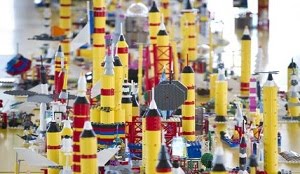"You are in the moment of discovery," state Division of Culture and History Commissioner Randall Reid-Smith said Wednesday during a media tour of the new $17.3 million museum, which opens free to the public on June 21 at the state Cultural Center in Charleston.
Visitors following the museum's central show path from prehistoric to present times will walk on replicates of dirt roads with plenty of boot prints, cobblestone streets of yesteryear, railroad tracks, asphalt highways, grass and other surfaces while taking in more than 6,000 artifacts representing all areas of the state.
Artifacts include a telescope George Washington used to survey West Virginia land, a grandfather clock belonging to the family of pioneer Mary Ingles and the noose used to hang abolitionist John Brown.
The 24,000-square-foot museum includes the show path and 26 discovery rooms dedicated to various topics and times in history, including ancient lands, frontier life, the Civil War, mining, 
More recent times are reflected in astronaut Jon A. McBride's NASA overalls and Olympic gymnast Mary Lou Retton's leotard and medals from the early to mid-1980s. Both are West Virginia natives.
Recent visitor reviews of the museum have included the descriptions "mini-Smithsonian" and "Disney," Reid-Smith said.
The West Virginia State Museum was designed to appeal to children and history buffs, but also to adults who may not think they are interested in history or do not realize it is a series of stories, said the museum's creative director, Stan Bumgardner.
"Once we engage them . . . then they'll want to learn more," Bumgardner said.
The show path takes visitors to 19th century Harpers Ferry, to Depression-era Main Street and to a 1950s-era drug store and soda fountain in downtown Charleston, as well as to an underground coal mine.
Details are so accurate that fake water spots in the mine replica at first startled Reid-Smith, who was briefly concerned there had been a leak.
Discovery rooms tell more stories of historic periods and events, as well as those of everyday West Virginians who might not be well known in state or national history, including widows of miners, Bumgardner said.
"We think West Virginia is special and it is a little different than any other place in the world, and it's because of its history and people," Bumgardner said. "That's the reason for all of this, is to tell the story of the people."
The new museum could attract about 250,000 visitors a year, estimated education director Nancy Herholdt, who added that figure would double the number of visitors to the old museum that closed in 2004.
"There's so much to take in," Herholdt said.
Gov. Joe Manchin, who briefly joined the tour, agreed, adding an earlier visit he made was not long enough.
"Two hours I was here - I thought I'd been here 20 minutes," Manchin said. "I want to really absorb this."
Self-guided tours may take anywhere from 45 minutes to two hours, but museum officials estimate that reading about every display, listening to each audio recording and watching all documentary videos would take about 26 hours.
Manchin said he loves history and wished he could spend an entire night at the museum. Some of his favorite exhibit topics include the Civil War and industrial eras.
"It exceeded our expectations," Manchin said. "It's a treasure for the people of West Virginia."
The museum displays just 10 percent of West Virginia's more than 60,000 historical artifacts.
Besides choosing the best artifacts to tell the state's story, other factors included tracking down any missing information on artifacts and adjusting display cases if artifacts did not fit.
Overall, most of the artifacts historians chose made it to the final display, Bumgardner said, adding, "We got the A list, B list and most of the C list."
As for the other 54,000 or so state artifacts, those may be among rotating pieces included in the commissioner's gallery, changing exhibit spaces and backup spaces, Bumgardner said.
The newly renovated museum was completed in May, and the state has been working on touchups ever since.
Under a $250,000 budget for funding new museum employees, West Virginia has hired five guest service workers and an audio-visual specialist, while two custodial service positions are still open, said Caryn Gresham, a public information specialist for the division.
Parking remains an issue, and state officials said a master plan for improvements to the State Capitol Complex includes that issue and that contractors will consider the museum in their plans.
"The State Capitol is a great tourist attraction for our West Virginia residents as well as visitors from other states and countries," said Diane Holley, communications director for the state Department of Administration. "The opening of the new State Museum will only enhance this interest to visit our beautiful campus."
Public parking is available at nearby Laidley Field and at metered spots surrounding the campus, Holley said, adding that buses for large group visits park on Greenbrier Street near the governor's drive so visitors can exit on to sidewalks instead of crossing streets.
West Virginia's new state museum opens at noon on June 21. Hours will be 9 a.m. to 5 p.m. Tuesday through Saturday and noon to 5 p.m. on Sundays. The museum also will be open Monday, June 22, from 9 a.m. to 5 p.m. but will be closed on Mondays after the first week.




0 comments:
Post a Comment